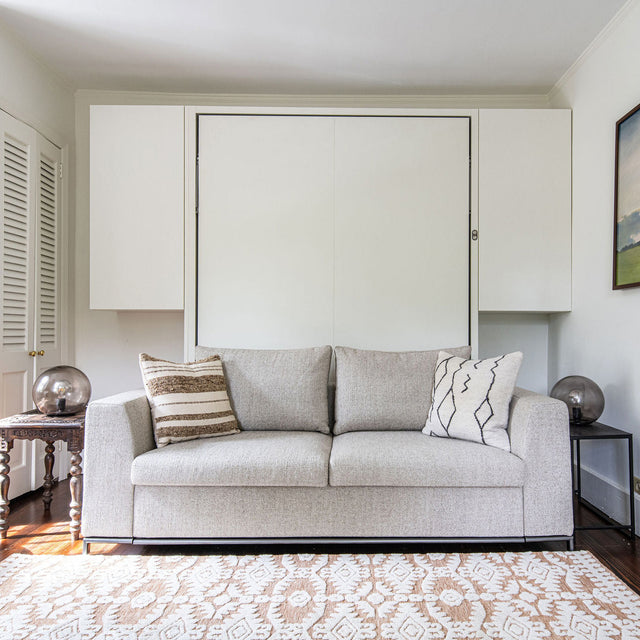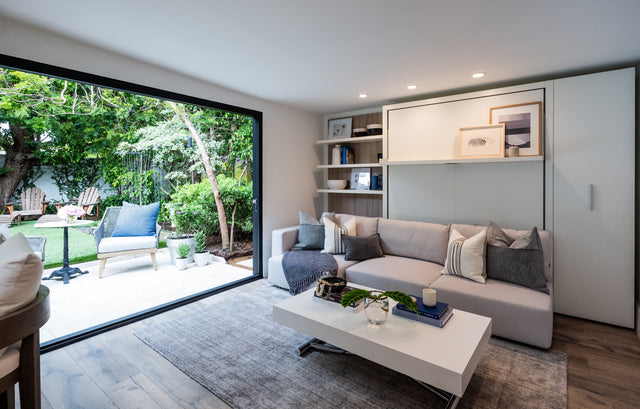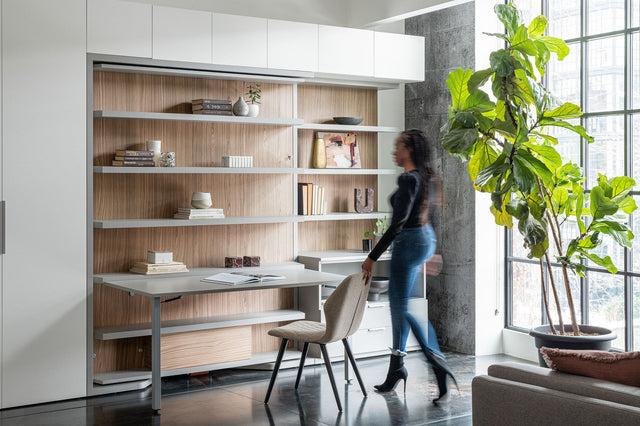Does Converting a Garage to a Living Space Add Value? What to Know Before You Start
A thoughtful garage conversion can transform your space. And yes, it often adds to your home’s value. For city dwellers and design lovers who want to add more room without building up or out, converting the garage into living space is a smart, often elegant choice.
A successful garage conversion requires careful design considerations. You’re balancing creativity with compliance—zoning, building codes, insulation, HVAC, the works. Done right, the finished room feels like a natural extension of the house. Done without care, it reads as an afterthought. Let’s make sure your project is a winner.
In this article:
-
Is a Garage Conversion Right for You?
-
Garage Conversion vs. ADU: What’s the Difference?
-
Benefits of Converting a Garage
-
How to Turn Your Garage into Living Space
-
Do You Need an Architect or Contractor?
-
Design Considerations for a Functional Garage Conversion
-
Can a Garage Conversion Increase Your Home’s Value?
-
Modern Aesthetic Trends in Garage Conversions
-
Design-Forward Solutions for a Stylish Garage Conversion
- Transforming Furniture For Garage Conversions
Is a Garage Conversion Right for You?
First, evaluate how you actually live. If you mostly use your garage to store bikes, seasonal items, tools, luggage, etc., valuable square footage is going unused. A quiet home office, a guest suite, a craft space—any of these options is feasible without touching your home’s footprint.
Of course, a garage conversion has tradeoffs. For example, you’ll lose your covered parking spot and that “everything drawer” of the house (a.k.a. the garage). Plan an alternative: where else can you store snow shovels and suitcases? A shed may solve this issue, or you could consider built-in storage in the converted space. It’s prudent to research your local rules early on in the project. Garage conversions involve permitting, electrical system, building codes, zoning requirements, and sometimes minimum parking standards. So, it’s better to confirm ahead than to demo and discover after the fact.
If the garage’s structure is sound and the local regulations align, converting a garage to living space can be one of the most cost-effective ways to expand your home, especially in dense neighborhoods where property add-ons can be difficult.
Garage Conversion vs. ADU: What’s the Difference?
A typical garage conversion folds the space back into your living space: den, office, playroom, studio. An ADU (Accessory Dwelling Unit), however, is different. It’s a small, self-contained residence with its own entrance—and usually a kitchen and bath. Think guest apartment, caregiver suite, or long-term rental.
ADUs require more planning and permitting. More trades, more inspections, a tighter checklist. But they also unlock options: rental income, multigenerational living, additional living space, and future flexibility. Converting an existing garage is often the fastest path to an ADU because you’re reusing the shell—foundation, walls, roof, concrete floors.
Which route is right? If you want livable space for your household, a straightforward conversion is often enough. If you want independence and potential ROI through renting, step up to the ADU.
Benefits of Converting a Garage
Let’s be real: most garages underperform. They’re cold in winter, sweltering in summer, and full of things you’d rather not look at. Reclaiming that space—thoughtfully—pays off.
A few real-world patterns we see:
-
A remote worker turns the garage into a sunlit office with a reading nook. The door used to rattle; now it opens to a small patio for mid-day calls.
-
An empty nester creates a calm guest suite for visiting kids (and, occasionally, paying renters). When no one’s in town, it doubles as a yoga studio.
-
A design-forward couple goes full ADU: compact kitchen, sleek bath, and a wall bed that disappears by day. It becomes both income and a beautiful extension of the property.
Why do these projects work so well?
More usable square footage. Lower cost than building new. Real potential for rental income if you go the ADU route. And when you handle the design and permitting properly, buyers tend to see value in finished, flexible space.
What makes these conversions so appealing is their flexibility. Today’s office can become tomorrow’s guest suite—or a cozy studio—without adding a single square foot to the lot.
How to Turn Your Garage into Living Space
Aside from the technical requirements of a garage conversion are the real life considerations for creating a living space in your garage. That said, here are three things to consider when your garage goes from hosting cars to hosting guests.
Invest in proper insulation and follow building codes.
First, remember to invest in all the proper building materials, codes, and permits required to meet your ultimate garage goals. While filing paperwork or hiring a great contractor seems like a momentous task now, in the long run, you’ll be grateful you invested in the structure, insulation, and electrical work required for a garage conversion.
Add warming colors, textures, and lighting.
Garages are typically cold or hot, depending on the natural climate surrounding it. Which means creating a warm, livable space goes beyond insulation and into the nitty gritty details, like warm lighting, cozy flooring, and textured materials throughout the design. Warm up or cool down the garage space depending on your style, but definitely don’t skip this step if you want a truly livable room.
Use furniture to create structure, flow, and room purpose.
Since garages are quite large, you’ll need furniture, wall storage, and seating to create structure in the room. Without these elements, it will feel like a large space, but without purpose. By thoughtfully planning out your furniture, you can make the most out of a garage living space.
These are just a few basic considerations, but we can go deeper, for example, do you need a contractor? Let’s discuss the options.
Do You Need an Architect or Contractor?
Short answer: almost certainly. You’re changing use and upgrading systems, which means plans, permits, plumbing work, electrical outlets, and coordination across trades.
An architect or residential designer helps you solve the layout (where to put windows, how to level the floor, how to add storage without crowding the room) and prepares drawings your city will approve. They also catch details like egress, insulation values, and structural needs when you replace the garage door with a framed wall.
A licensed contractor executes the plan and lines up electricians, plumbers, and HVAC pros. If you’re adding a bathroom or kitchenette, their sequencing and code knowledge are non-negotiable. Design-build firms can be great here—they handle both drawings and construction so you’re not the go-between.
Could you DIY parts? Sure—painting, fixtures, some finishes. But bring in pros for the structural, electrical, plumbing, and permitting. It’s safer, cleaner, and it protects resale value.
Design Considerations for a Functional Garage Conversion
Garages come with quirks. The floor slopes. The ceiling’s a bit low. The door sticks. The fix is a plan that treats the space like any other room in your home—comfortable, efficient, and beautiful.
Insulation and climate control
Garages aren’t designed for comfort, and you may need an HVAC system. Insulate walls and ceilings, and don’t forget the floor assembly. A ductless mini-split is a quiet, efficient way to heat and cool without touching existing ductwork.
Flooring
Let’s talk about flooring material. First, level the slab so the room flows with the rest of the house. Then choose a finish that suits the use: engineered wood for warmth, polished concrete for a modern edge, cork for softness and sound.
Natural light
Replace the garage door with glazed French doors or a large window wall if you can. Skylights, clerestories, or a single well-placed window can make a huge difference in a small space.
Plumbing and Power
Adding a bath or kitchenette? Place it near existing lines to reduce trenching. Plan for dedicated electrical circuits and an electrical panel; studios and home offices can be surprisingly power-hungry.
Storage
You’re losing a big storage zone, so design it back in. Built-ins, modular cabinetry, window seats with hidden compartments—storage that looks like furniture keeps the room calm.
When those elements work together, the conversion doesn’t read as “former garage.” It just feels like an actual living space you can call home.
Can a Garage Conversion Increase Your Home’s Value?
In many markets, yes—especially when the work is permitted, well-insulated, and finished to the same standard as the rest of the house. Appraisers look at livable square footage, and buyers respond to spaces that solve real problems: a quiet office, a guest suite, a legal rental.
Will you recoup every dollar? Results vary. High-quality work typically returns a significant share, and you also gain daily utility you’d never get from a storage bay. In parking-tight neighborhoods, consider adding a carport or dedicated outdoor storage to offset the loss of the garage—smart tradeoffs keep value strong.
The big rule: make it legal and make it lovely. Unpermitted work can hurt resale. Professional design and construction do the opposite.
Modern Aesthetic Trends in Garage Conversions
These days a converted garage shouldn’t feel patched together. It should look deliberate — the kind of room a buyer glances at and immediately understands. Here are five trends that actually change how the space lives and how it sells.
Open layouts
Less walls. More light. Let furniture do the dividing: a low sofa backs the sleeping area, a rug marks the work nook, a slim console separates a tiny dining spot. The room feels bigger and breathes. It’s also more useful: one person can work while another exercises, and guests can sleep over without bumping into each other.
Industrial warmth
Keep the honest bits — concrete, an exposed beam, an original block wall — then soften them with warm wood floors, a plush rug, and matte metal fixtures. The contrast feels authentic, not “leftover.” Buyers notice craft and materials; those details signal a real renovation rather than a cheap flip.
Biophilic touches
Bring the outside in. A large window, a planted sill, or natural finishes make a compact room calmer and more desirable. You don’t need a jungle. Even a single, well-placed plant and morning light that hits the chair will change the room’s mood and how people value it.
Luxury details
Small rooms win on detail. Integrated lighting, cabinetry that hides clutter, and solid hardware are the things people remember. A compact bath with a good tile and a thoughtful vanity reads as care, not compromise. Spend on one well-done element — it lifts the whole space.
Flexible design
If the room can only do one thing, it’s a missed opportunity. Wall beds, fold-down tables, and modular seating let the space change in a minute. The right furniture makes the room an office by day, a guest suite by night, and a rental in between. That adaptability is both practical and a clear selling point.
Why this matters
Good design here isn’t decoration. It’s persuasion. A bright, well-finished, and flexible garage reads as useful living space rather than an add-on. Buyers want rooms that solve problems — a place to work, a place for guests, or a legal rental — and those choices make the space easier to sell and justify a stronger price.
Design-Forward Solutions for a Stylish Garage Conversion
Once the envelope is done, furnishing a garage conversion decides how the room lives day to day. And this is where multifunctional pieces shine.
A wall bed can turn an office into a guest room in seconds—no awkward futons, no visual clutter. A modular sofa shifts from lounging to sleeping for weekend guests. Tall, built-in cabinetry hides the practical stuff while showcasing books, art, and a TV. The right furniture lets one room do the work of three—without feeling cramped or cluttered.
This is the secret to small-space luxury: beautiful materials, integrated storage, and pieces that move with your life.
Transforming Furniture For Garage Conversions
If you’ve been eyeing that underused garage, consider this a nudge. With a clear plan, the right team, and furniture that earns its footprint, a conversion can give you the space you’ve been missing—office, retreat, guest suite, or an elegant ADU.
Curious what that could look like in your home? Visit a Resource Furniture showroom or book a virtual consultation. We’ll help you map the layout, choose transforming pieces that fit your style, and make every square foot work harder—beautifully.
Recent Posts

6 Ways to Create a Hotel-Like Guest Room Experience

Aging in Place That Actually Feels Like Home

Does Converting a Garage to a Living Space Add Value? What to Know Before You Start

Multifunctional Kids' Room by YZDA at Armani Casa Miami

When Every Inch Counts: A Multifunctional Retreat in Cobble Hill








